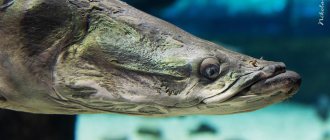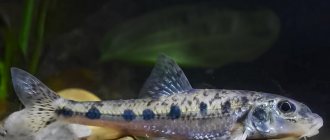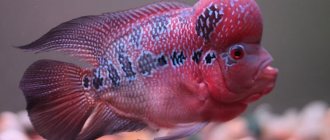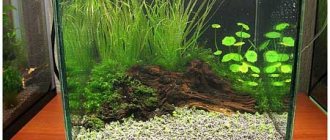Protopterus is a fish common on the African continent and belongs to the Protopterus annectens family. The genus is double-breathing, since its representatives have both gills and lungs. The latter cover 98% of the oxygen requirement, and the gills only 2%. Protoptera is divided into four species, differing only in external characteristics and habitat. Fish love tropical climates and prefer to live in fresh, preferably stagnant, bodies of water that are prone to drying out.
Protoptera is an ancient fish that breathes with both lungs and gills.
Appearance of lungfish
Protoptera resemble more a snake than a fish. The body is elongated, oblong. The fins on the chest look like cords, the dorsal fin is long, starting from the middle of the body and reaching the end of the tail. The body is covered with small scales.
Features of the species:
- Marble protopter (large). The largest representative, the body length reaches up to two meters and weighs about 17 kg. The name matches the color. There are bluish and gray shades combined with a pattern reminiscent of marble.
- Brown protopter. Grows up to one meter, approximate body weight 5 kg. The color scheme is varied, the back area is greenish-brown, the sides are less bright, the belly is white with a grayish tint.
The length of the brown protopter is on average 1 m - Dark protopter. The body is slightly less than a meter, on average 80-85 centimeters. The average weight is 11 kg, large individuals gain up to 17 kg. The body is dark gray, in general the fish resembles an eel.
- Small protopter. A small species of grayish color, about half a meter long and weighing 2 kg. In addition to differences in color, there are structural features. Young representatives have three pairs of fins, which remain for a long time.
Protopter: A fish that is not caught, but dug out of dry ground, like potatoes
Don't leave the room, don't make a mistake - many took this saying as a guide to action, but our guest today elevated it to a motto. Today we have on the menu a comatose fish, a sociopathic fish, a survivalist fish: protopter!
When dad takes you out of the room to show you to the guests.
This animal looks the least like a fish. Small pig eyes sparkle dully on a flat muzzle devoid of any shadow of intelligence, a long (up to 2 meters) eel-like body without scales, some four sticks instead of fins... Yes, kamon, author, is this really a fish?
These antennae are the only fins on the fish's body. With their help, the animal walks along the bottom, as if on legs.
Yes! And not just any fish, but a very ancient one! This weak-sighted sausage appeared on Earth about 99 million years ago! The Protopter has survived dinosaurs, woolly rhinoceroses, the collapse of the USSR, and it seems that it will be the only one that will wait for Half-Life 3. With such a whirlwind of events, from the moment of its inception to the present day, the Protopter has virtually not changed. Why change anything if the basic configuration turned out to be extremely successful?
Your face when Half-Life VR was released instead of Half-Life 3.
Firstly, it is double-breathing, that is, it can breathe with both gills and lungs. This gives +100 to survivability in case of various troubles. But there are plenty of troubles in his homeland, Africa. The protopter waits out droughts in liquid mud, and in hungry years it goes for food to land that is hostile to other fish...
Speaking of food, the protopter hunts based on taste. Remember those Chinese fin sticks sticking out of our lung sausage? They are dotted with taste buds, like our tongue. With their help, the sad creature slowly waddles along the bottom - but only until it smells its prey. At that same second, the fish loses its sleepy stupor and furiously rushes to eat.
OOOOO GREEN-EYED TAXI.
But little is known about how they reproduce. Most likely, the female lays eggs. Most likely, the male fertilizes the eggs and guards the clutch. Most likely, it drives away enemies. The only thing that is known for certain is that during the breeding season, these unsociable creatures hate each other’s company a little less than usual.
It’s been on earth for 99 million years, and it’s still blowing bubbles, what a shame!
But the most interesting thing about this fish is how it survives bad times. And the protopter has these regularly once a year: in Africa, where they are widespread, the drought season spares no one. In case of a merciless dry forest, the protopter has a unique mechanism. As soon as the water level drops, it digs a hole, closes itself, curls up tightly and covers itself with a thin film of mucus, which will replace water for the animal.
The thickness of the film is negligible, but if it is damaged, the protopter is guaranteed to die, since the fish will simply dry out.
The fish can live in this state for a month. Or maybe a year. Or maybe four. During his seclusion, he does not eat, does not move, goes to the toilet under himself, and breathes extremely rarely. Moreover, he loses weight, and not due to fat, but due to muscles! That's the one who sat down to dry the wrong way. And yes, the protoptera is still eaten by the locals. But how can you catch it when the insidious root crop buries itself half a meter into the ground?
While we dig up potatoes, Africans dig up fish.
Locals go fishing not with a fishing rod and bait, but with shovels and musical instruments. The cunning natives constructed drums that imitated the sounds of rain. When performing drum solos, local jazzmen listen to sounds from underground. And as soon as they hear the awakened fish, they rush frantically to dig for their prey.
The Book of Animals was with you!
Habitat of protopters in nature
Protopter lives in Africa, or rather in its equatorial zone and tropics. The climate favorable for fish allows the colonization of large areas. Distributed in Nigeria, Cameroon, Gambia, Niger and other neighboring countries.
Protopter lives in African countries
Each species occupies a specific habitat. The brown protoptera is found in the river basins of western Africa. The small one lives in the Zambezi Delta, in the southern territories. Dark, the rarest, is found only in the Congo River, and marbled east of Sudan.
All representatives prefer the same living conditions. The fish feels comfortable in fresh water bodies that are prone to drying out, but some subspecies can tolerate brackish water. Settles in small lakes, oxbow lakes or flooded hollows.
Lifestyle
Increased activity of protopters is noted in the evening, and then they go hunting. Due to the fact that pulmonary respiration prevails over gill respiration, the fish has to stay closer to the surface in order to regularly gain a portion of oxygen. This process is accompanied by a loud sound, similar to a scream. At night, climbs occur more often than during the day.
Based on these facts, it follows that the protoptera is nocturnal. With dawn, the activity of the animal subsides, movements slow down, and the fish settles to the bottom.
Individuals prefer solitary swimming and do not like company, including their relatives. Having met, the two representatives begin to behave aggressively and start a fight. The protopter drives strangers away from the territory or eats them.
Diet of protopters in nature and aquarium
When moving, the protopter uses either the bends of its body or its fins. The latter are indispensable not only in movement, but also in hunting, as they are dotted with taste buds. Feeling the space with its fins, the fish distinguishes between edible and non-edible objects. Having identified the prey, it instantly pounces and grabs.
Protoptera are omnivorous; they can feed on plants or shellfish.
Representatives of all four species are not picky about food; they prefer a diet of mollusks, crustaceans, amphibians, and other fish. Sometimes the menu contains plant foods. Juveniles primarily consume insects.
The jaw of the African protoptera has no teeth; their function is performed by forked plates. Having grabbed the victim, it begins to chew thoroughly, gradually plunging it into the oral cavity. Then he spits it out and repeats the procedure several times. When the food reaches the desired consistency, it is swallowed.
In an aquarium, food includes pieces of fish, shellfish, snails, shrimp and even meat. They are given using plastic tweezers or simply by hand. The protopter can go a long time without food, so the regularity of feeding is not particularly important. It is optimal to add food to the aquarium every other day, mainly in the evening. Frequent feeding combined with a sedentary lifestyle contributes to obesity.
Nutrition
When hunting, protopterans rely heavily on their excellent sense of smell and their rope-like fins, which are studded with sensitive taste buds. Slowly traveling along the bottom, they probe the silt beneath them for the presence of something edible. The protopter does not grab its prey, but sucks it in.
The main menu of adult individuals includes small crustaceans, mollusks, freshwater crabs, as well as small fish. The juveniles feed on insects. They also eat a little unusually, spitting out and re-swallowing their prey several times.
Another feature of protopters is their ability to fast for a long time (up to 3 years), during which they periodically fall into torpor, but do not die.
Features of fish reproduction
Despite the fact that the protopter cannot tolerate its relatives, reproduction is still in pairs. Upon reaching sexual maturity (at 3 years), males and females meet during spawning to leave offspring. This process takes place in several stages:
- The future father prepares the place, climbs deep into the vegetation and digs a hole with two passages.
- The bottom of the shelter makes it spacious. The female lays up to 5,000 eggs there and swims away.
- The male occupies a guard post, hiding in one of the dug passages. If danger arises, it attacks immediately.
- The eggs mature within a week and the fry hatch on the eighth day. After another 12 days, the grown young animals leave the mink. Abandoned housing can be used for the next spawning.
For mating fish, they build cozy homes.
Breeding in an aquarium is impossible. A small protopter is more likely to gnaw on a relative without starting fertilization, and it is unrealistic to recreate conditions similar to natural ones.
Unique ability
When a period of drought occurs, the African lungfish chooses a suitable place and digs a hole, usually among dense vegetation. When a certain depth is reached, it forms something like a chamber and is placed with its head up towards the exit. As the water recedes and air enters the chamber, the fish begins to secrete a special mucus, which hardens and forms a kind of impenetrable cocoon. From this moment on, changes occur in the body, the metabolic rate decreases sharply. A state known as hibernation occurs. This is how the fish spends the entire dry season. With the first drops of rain, she wakes up and leaves her shelter. It is worth noting that in unfavorable conditions, hibernation can last several years!
Hibernation is an important stage in the life of protopters
A unique ability of protopters, which cannot be found among other fish, is to hibernate. This is a necessary measure to survive the drought period.
Getting ready for bed is an important event and is always done in advance. It involves the formation of a sleeping nest. Large individuals begin to fuss when the water drops to 10 centimeters. Small fish feel comfortable at such a depth and begin construction only at a level of 5 centimeters.
The nesting site should be soft and muddy. The protopter grabs soil with its mouth and gets rid of it through the gills. As a result of digging, a vertical tunnel is formed, with a depth of 30 to 50 centimeters. Next, the fish expands the lower area to organize a sleeping area.
The protopter climbs into the dug house, facing outward, and begins to move back and forth. Thanks to such movements, the clay rises, which closes the hole. The preparations don't end there. Even after the formation of the upper clay cap, the fish continues its forward action. Head impacts make the exit convex, similar to a cap. It gradually hardens and the fish calms down. Cracks form on the surface through which air enters the burrow.
Having completed construction work, the fish releases a large amount of mucus. As the water leaves, a viscous substance envelops the body. Inside such a cocoon, the protopteran individual is grouped into a compacted ball, while the mouth remains slightly open to breathe.
During hibernation, the fish buries itself at the bottom of the reservoir.
The fish wakes up as soon as the habitat is filled with water again. She needs about a day to straighten up, take on her previous appearance, and establish coordination.
Lifestyle
As a result of research, a number of scientists have come to the conclusion that this is one type of fish, which is divided into 4 subspecies. The lifestyle of the protopter is the same, regardless of habitat. Although there is one typical subspecies that can live in brackish water.
Protoptera represents the family of African two-legged fish. Its lifestyle is different from many other aquatic inhabitants. The protopter is able to survive without water for many months during drought periods when water bodies dry up. The biological characteristics of this fish are adapted to breathe atmospheric air and hibernate for a long time.
What should an aquarium look like and care for it?
In captivity, protoptera are not prone to active movement, so the volume of the aquarium depends on the specific species. For example, for protopterus amphibius to live comfortably, a capacity of 150-200 liters is enough, but to contain the species protopterus aethiopicus, a thousand-liter aquarium is required. Be sure to cover the container with a lid, otherwise the pet will escape. It is important to maintain a sufficient air gap and ensure a regular supply of atmospheric oxygen.
Coarse sand is used as soil; fixed driftwood and smooth stones serve as decoration. It is better to avoid vegetation; the fish will quickly get rid of it. If you want greenery, you can install artificial objects made of plastic.
Protopters prefer dim lighting. They love clean, standing water at a temperature of 25-27 degrees, and are sensitive to pollution. Therefore, it is necessary to install a filtration system that will not produce vibrations. Streams and seething irritate the pet, he becomes restless.
Half the volume of water is changed at least once a week. Since the fish does not get along with cleaners, you have to remove organic residues yourself.
What fish can protopters get along with?
Unfortunately, protopters are aggressive and do not tolerate anything living on their territory, so breeders have to admire only its beauty and habits. These fish do not allow the existence of not only their relatives, but also the rest of the inhabitants of the aquarium; they even attack large individuals. Anything they cannot eat is mercilessly mutilated.
Protoptera prefers solo swimming in an aquarium
Solitary confinement is the only optimal option for representatives of this species.
Fish diseases and methods of treating them
In the wild, fish are able to cope with negative environmental factors. Hibernation helps the protopter survive an unfavorable period. In captivity, a pet cannot use this effective method. Therefore, if the aquarium conditions and care are not suitable, the fish becomes lethargic and tries to find a closed place to sleep. The owner should pay attention to this behavior and provide the pet with a comfortable living environment.
Protopter is an unusual fish, it is hardy in its habitat and takes root well in captivity. In nature, local residents catch it for meat, and in European territory they use it as an aquarium inhabitant.











